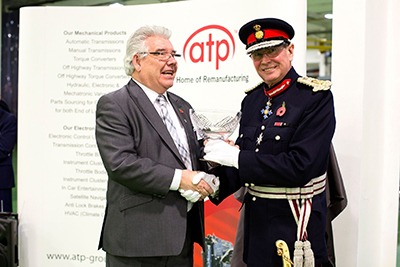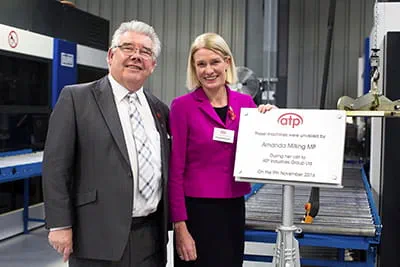UK transmission remanufacturing specialist ATP Industries Group has embraced an automatic cleaning solution, which it says improves speed, efficiency and sustainability – and even the work environment itself. Doris Schulz investigates
Cleaning is a vital part of remanufacturing operations and getting it right can provide real dividends. British transmission remanufacturer ATP Industries Group, for example, was finding inefficiencies in its processes so cast around for alternatives. The answer came in the shape of a fully-automatic solution from cleaning technology specialist Dürr Ecoclean UK. ATP says that switching from an aqueous cleaning process with numerous manual interventions has enabled it to boost product quality. But more than this, the new solution – employed in three enclosed systems using a non-halogenated hydrocarbon – has also yielded substantial improvements in cost efficiency, working conditions and sustainability, the company insists.

Worldwide customers
Founded in 1969, ATP has long argued that rebuilding vehicle components such as transmissions is an activity that saves raw materials, energy and costs. Set up by Alan Smart and based in Cannock Wood in the English county of Staffordshire, the enterprise has evolved into Europe's largest independent remanufacturer of automatic and manual transmissions, transfer boxes and other mechanical and mechatronic drivetrain components for cars and off-highway vehicles. "Our customers include vehicle manufacturers such as Ford, Fiat-Chrysler, Volvo, Aston Martin, Land Rover and JCB, to whom we supply products and services into 35 countries worldwide out of our headquarters plant and subsidiary sites in the US and China," explains Mark Bowen, sales director at ATP. The quality of the product, rebuilt to the most exacting global standards, is an important success factor, he says. Addressing this requirement, ATP has developed solutions including a highly sophisticated, technically-demanding test rig for precise validation and calibration of the electronic, hydraulic, mechanical and software functions of dual clutch transmissions. As recognition of this innovation, ATP was honoured with Britain's most prestigious industry award, the Queen’s Award for Enterprise – Innovation Category, in 2016.
Achieving objectives
In line with the quality standard, all components of a reconditioned unit must be like new - and in some instances better than new - both technically and visually. To achieve this objective, the incoming transmissions and components were initially cleaned and disassembled by hand at ATP. Next, the individual parts made of aluminium, steel, cast iron, plastics and other materials were pre-cleaned with brushes and a solvent at dedicated cleaning stations in order to remove oils, greases, carbon deposits and road dirt. Any foreign matter still adhering to the parts used to be removed in simple, semi-automatic washers using an aqueous medium, and then the parts were dried manually with compressed air. There were problems with this way of doing things. This was, for one thing, a very time- and labour-consuming workflow.
Parts rejected
Moreover, around 20% of all cleaned parts were rejected as not clean enough by the quality control department and had to pass through the cleaning process again. On the other hand, the cleaning method gave rise to an unwholesome work environment with elevated air humidity, airborne oil particles and high noise levels. Operators in these areas had to wear ear protectors. "About three years ago, we therefore consulted various cleaning equipment manufacturers to learn about alternatives,” recalls Adrian Aston, technical director at ATP. “Dürr Ecoclean UK presented us with a very attractive solution at the time but it exceeded our budget. As for the other vendors, their systems called for investments that were out of all proportion to the achievable improvement. For a while, therefore, we simply continued to work as before.”
Convincing test results
Last year, prompted by brisk growth in demand and the company's own rising quality requirements, ATP's management approached Dürr Ecoclean again and carried out a series of initial cleaning trials at the UK test centre. This was rounded out by further testing with genuine parts at the Filderstadt test facility in Germany. "The results were so impressive that we ordered two EcoCCore type cleaning systems right away,” Aston adds. The innovative solvent-based cleaning system that can work with hydrocarbons and modified alcohols is run with a non-halogenated hydrocarbon at ATP. Operating under full vacuum, it features a built-in distilling system plus full-flow and bypass filtration for continuous solvent reconditioning, thus providing a long solvent life and low consumption. Its extensive standard equipment package includes two flood tanks for the coarse- and fine-cleaning treatment as well as heat recuperation.

Significant quality improvement
Following disassembly, the transmission parts are now arranged in a defined position in cleaning baskets measuring up to 670mm x 480mm x 400mm, adapted to the size of the work chamber. These baskets are conveyed to the machines in the cleaning section where an operator selects the appropriate cleaning programme. At present, ATP uses nine different programmes with process parameters set to match the respective transmission type, material and degree of contamination. The cleaning cycle takes between 6 and 14 minutes to complete. "We clean 65 baskets per shift in each system, with just one lady operator in attendance. Before, we needed between eight and ten operators to clean these parts,” Aston reports. To achieve the required cleaning result in such a short time, the EcoCCore is equipped with innovative process technology such as advance steam degreasing. With this technology, the oil-containing solvent is not passed into the flood tank - contrary to common practice - but is directed straight into the distillation unit. This design minimises oil deposits in the flood tank while counteracting the accumulation of oil in the solvent. Moreover, the machines feature ultrasonic devices in addition to the standard injection flood wash system. Ultrasound and filtration can be used simultaneously, and the volumetric flow rate is frequency-controlled. Particles are thus discharged concurrently as cleaning proceeds and cannot settle in the work chamber. "We check our cleaning quality by gravimetric tests once per week,” Aston continues. “With the EcoCCore, we have been achieving approximately 30% better results on a consistent basis.”
Getting payback
This huge quality gain prompted ATP to adopt automatic cleaning also for the mechatronic components, which were still being cleaned manually. The company therefore invested in an EcoCBase machine which is likewise equipped with two fluid tanks plus ultrasonic cleaning and operates with a hydrocarbon cleaning medium as well. The work chamber is designed for cleaning baskets measuring up to 530mm x 320mm x 200 mm. The throughput of this machine amounts to 35-40 baskets per shift. The improved cleaning results helped ATP to further optimize product quality, which has already generated additional business, it says. The company also reports substantial gains in productivity and cost-efficiency. Likewise, the new cleaning process is top-notch in terms of sustainability. The water consumption of the old cleaning systems amounted to around 100,000 litres per year, a volume that is now saved. This is in addition to the savings on cleaning chemicals. "Payback on the new machines will occur much sooner than we had calculated,” Aston concludes. “In addition, we benefit from a much more pleasant and cleaner work environment. Our clients and ourselves have gotten so used to this situation that we are already in discussions with Dürr about the purchase of a fourth system – for cleaning the complete transmissions prior to disassembly so that here, too, visible cleanliness will be achieved.”






